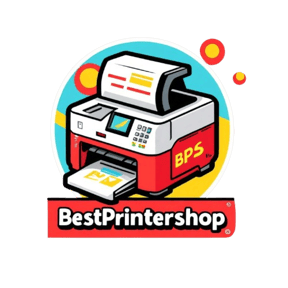Best Color Printers for Stickers and Labels
Is your labels printer giving you trouble? Learn the common signs that indicate it’s time to replace your printer. Discover how upgrading can boost your productivity and save you money.
Praveen Kumar - Canon Printer Specialist
12/29/20247 min read


Introduction to Label and Sticker Printing
Are you struggling to find a printer that produces high-quality labels and stickers without breaking the bank? Perhaps you’ve tried using a regular printer, only to be disappointed by prints that lack the sharpness or durability you need. Low-quality labels and stickers can have serious repercussions, especially for businesses or creative projects. Faded prints, smudged designs, and the inability to handle different label sizes can lead to frustration, wasted resources, and a less-than-professional appearance. But don't worry—this guide is here to help! We’ll explore the best label and sticker printers available today, catering to a variety of needs, whether you’re a small business owner, a craft enthusiast, or managing large-scale industrial operations. This comprehensive blog post will walk you through the types of label printers, key features to consider, and top models for specific uses. By the end, you’ll have all the information you need to confidently choose the perfect printer to meet your requirements.
Key Features to Consider When Choosing a Label Printer
Selecting the right label printer involves more than just looking at the price tag. It’s about finding a device that fits your specific needs and delivers the functionality you require. Here are the essential features to focus on when making your choice:
1. Print Speed and Resolution
For businesses with high-volume label requirements, print speed is a top priority. Industrial setups should aim for printers with speeds of 4–6 inches per second, while craft or small business users may find 2–4 inches per second sufficient.
Resolution matters too. For sharp text and vibrant designs, look for printers with a minimum resolution of 300 dpi (dots per inch). For intricate details, such as those on vinyl stickers, opt for 600 dpi or higher for superior clarity.
2. Connectivity Options: USB, Wi-Fi, and Ethernet
The connectivity of your label printer can greatly affect your workflow.
USB: Ideal for straightforward, direct connections to your computer.
Wi-Fi: Perfect for wireless printing and sharing the printer among multiple devices.
Ethernet: A reliable choice for office setups where multiple team members need access simultaneously.
Some modern printers also offer Bluetooth connectivity, allowing you to print directly from smartphones or tablets, making them versatile for various use cases.
3. Compatibility with Different Label Sizes
A printer’s ability to handle a variety of label sizes is crucial, especially if you’re printing shipping labels, product tags, or custom stickers.
Wide Label Support: Ensure the printer can handle both small labels (e.g., 2x2 inches) and larger ones (e.g., 4x6 inches for shipping).
Custom Sizes: Look for adjustable trays or settings that accommodate non-standard label dimensions.
4. Software Support for Label Design
User-friendly software is essential for creating professional-looking labels. Check for printers that offer:
Pre-made Templates: Save time with ready-to-use designs.
Customization Features: Add elements like logos, barcodes, or unique fonts to make your labels stand out.
Third-party Integration: Ensure compatibility with design tools like Photoshop or Illustrator and e-commerce platforms like Shopify or Amazon.
5. Durability and Maintenance
A reliable label printer is a long-term investment. Here’s what to look for:
Heavy-duty Build: Necessary for industrial and high-volume environments.
Ease of Maintenance: Features like replaceable print heads and rollers can prolong the printer’s lifespan.
Warranty: A comprehensive warranty reflects the manufacturer's confidence in the product's quality and reliability.
6. Additional Features Worth Considering
Automatic Cutter: Ensures clean, precise label cuts.
Multiple Print Modes: Options like peel-off, tear-off, or continuous printing enhance versatility.
Energy Efficiency: Eco-friendly models reduce electricity usage and operational costs.
By focusing on these features, you’ll be equipped to choose a label printer that meets your needs, whether for personal projects or professional operations.
Comparing Inkjet, Laser, and Thermal Label Printers
When choosing the best label printer for your needs, it’s essential to understand the differences between inkjet, laser, and thermal technologies. Each type offers unique advantages, and your decision will depend on factors such as cost, printing volume, and the type of labels you want to produce. Let’s explore the strengths and limitations of each to help you make an informed choice.
1. Inkjet Printers for Labels
Inkjet printers are well-suited for creating high-quality, detailed labels with vibrant colors. They use liquid ink sprayed onto paper to produce images and text.
Advantages:
Exceptional Print Quality: Inkjet printers deliver rich colors and intricate details, making them ideal for custom stickers or product labels with complex designs.
Material Versatility: They can print on various surfaces, including glossy, matte, and textured labels.
Affordable Initial Investment: Inkjet printers are often less expensive upfront compared to laser models.
Disadvantages:
Higher Operating Costs: Ink cartridges can be costly and require frequent replacement, especially for high-volume printing.
Slower Speeds: Printing with inkjet printers takes longer compared to laser or thermal printers, which can be a drawback for large-scale operations.
Susceptible to Smudging: Ink is prone to smudging, especially when exposed to water or heat, making inkjet labels less durable in challenging environments.
2. Laser Printers for Labels
Laser printers use toner and a laser beam to produce sharp and smudge-resistant prints. They are known for their efficiency and are often used for professional label printing.
Advantages:
High-Speed Printing: Laser printers excel at printing large volumes quickly and efficiently.
Cost-Effective for High Volumes: The cost per page is lower than inkjet printers, especially for monochrome printing.
Durable and Smudge-Resistant Prints: Laser-printed labels are less likely to smudge or fade, even in demanding conditions, making them ideal for shipping labels or barcodes.
Disadvantages:
Higher Initial Investment: Laser printers have a higher upfront cost, which might be a challenge for hobbyists or small businesses.
Limited Color Vibrancy: While color laser printers are available, they are pricier and do not achieve the same vividness as inkjet printers.
Bulky Size: Laser printers are generally larger, which can be a concern for smaller spaces or home offices.
3. Thermal Printers for Labels
Thermal printers use heat to transfer images onto paper, with two types: direct thermal and thermal transfer. Direct thermal printers apply heat directly to coated paper, while thermal transfer printers use a ribbon to transfer ink onto the label.
Advantages:
No Ink or Toner Required: Thermal printers eliminate the need for ink or toner, reducing ongoing costs.
Fast and Efficient: These printers offer quick printing speeds, making them ideal for high-volume applications.
Durable Labels: Thermal prints are resistant to smudging and suitable for harsh environments, such as shipping and outdoor use.
Compact and Reliable: Thermal printers are typically smaller and more durable, making them a great option for small businesses and industrial settings.
Disadvantages:
Limited Color Options: Thermal printers are mostly used for black-and-white labels. Color thermal printers exist but are less common and more expensive.
Specialized Supplies: Direct thermal printers require thermal paper, and thermal transfer printers need ribbons, which can add to operational costs.
Fading Over Time: Direct thermal prints may fade when exposed to heat or sunlight, making them less ideal for long-term labeling needs.
Which Printer Should You Choose?
Inkjet Printers: Best for producing vivid, high-quality labels in small batches. Ideal for creative projects, stickers, and product packaging with intricate designs.
Laser Printers: Perfect for high-volume, professional printing of shipping labels, barcodes, and other monochrome applications where speed and durability are crucial.
Thermal Printers: The go-to option for fast, cost-effective labels designed to withstand rough handling. Great for shipping, inventory management, and barcode labels in industrial or retail settings.


Maintaining Your Label Printer: Tips for Longevity and Performance
To ensure your label printer operates efficiently and has a long lifespan, proper maintenance is essential. Neglecting care can lead to reduced print quality, slower performance, and unexpected breakdowns. Below are key practices to keep your label printer in top condition.
1. Regular Cleaning
Dust, adhesive residue, and debris can accumulate inside the printer, impacting performance and print quality. Regular cleaning prevents these issues.
Steps to Clean Your Printer:
Turn off and unplug the printer before cleaning to avoid electrical hazards.
Use a soft, lint-free cloth to clean the exterior.
Use compressed air to remove debris from the interior.
Clean the print head with a cotton swab dipped in water (inkjet) or alcohol (laser).
Wipe the paper feed rollers to remove dust and adhesive buildup.
Clean label sensors with a soft cloth to ensure proper label detection.
Why It Matters:
Routine cleaning maintains print quality, reduces paper jams, and extends the printer's lifespan.
2. Timely Cartridge Replacement
Running a printer with low ink or toner can lead to poor print quality and potential damage to internal components.
How to Replace Cartridges:
Monitor ink or toner levels regularly; many printers provide alerts for low supplies.
Use compatible or original cartridges to avoid compatibility issues.
Follow the manufacturer's instructions for proper installation to prevent leaks or damage.
Participate in cartridge recycling programs to reduce environmental waste.
Why It Matters:
Prompt replacement ensures optimal print quality and prevents strain on the printer’s mechanisms.
3. Update Firmware and Software
Keeping your printer’s firmware and software updated ensures compatibility, improved performance, and access to new features.
How to Update:
Check the manufacturer’s website for firmware updates.
Use the printer’s control panel or connected computer to install updates.
Ensure your driver software is the latest version.
Enable automatic updates if available.
Why It Matters:
Updates address bugs, improve performance, and ensure compatibility with the latest operating systems.
4. Proper Storage
When not in use, storing your printer correctly protects it from damage and ensures it’s ready when needed.
Storage Tips:
Place the printer in a dry, cool location away from direct sunlight or high humidity.
Use a dust cover to protect it when idle.
Disconnect the power source during extended non-use.
Store labels in a cool, dry environment to maintain adhesive quality and prevent warping.
Why It Matters:
Proper storage prevents dust buildup, internal damage, and label degradation.
5. Perform Test Prints
Regular test prints help identify and address issues early, such as alignment problems or low ink levels.
How to Perform Test Prints:
Use the printer’s settings menu to print a test page.
Check for alignment, print clarity, and label feed accuracy.
Address any issues promptly, such as cleaning print heads or adjusting label placement.
Why It Matters:
Test prints catch problems early, saving time, resources, and money in the long run.
6. Use High-Quality Labels
Low-quality labels can cause paper jams, smudging, and increased maintenance needs.
Choosing the Right Labels:
Ensure labels are compatible with your printer type (inkjet, laser, or thermal).
Use trusted brands for durability and reliability.
Store labels in a dry, cool place to prevent curling or adhesive issues.
Why It Matters:
High-quality labels improve print output, reduce jams, and protect the printer from damage.
7. Address Paper Jams Quickly
Paper jams can cause frustration and damage the printer if not handled properly.
Preventing and Fixing Jams:
Load labels correctly following the manufacturer’s guidelines.
Use labels of the correct size and type.
Turn off the printer and gently remove jammed labels to avoid damaging components.
Inspect and clean feed rollers regularly.
Why It Matters:
Promptly addressing jams ensures smooth operation and prevents long-term damage to internal parts.
Conclusion
By following these maintenance practices, you can maximize your label printer’s performance and longevity. Regular cleaning, timely cartridge replacement, software updates, proper storage, and high-quality materials will ensure your printer continues to deliver optimal results while minimizing downtime and repair costs.
Insights
Explore the latest in printer technology and tips.
Resources
Support
contact@bestprintershop.com
+918920029543
© 2024 BestPrinterShop . All rights reserved.
